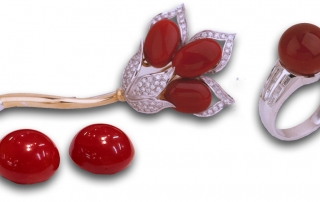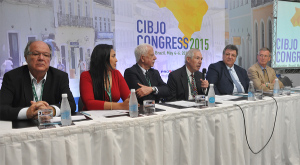CIBJO President guest of honour at EXPO Joya in Guadalajara, Mexico, endorses agreement promoting Latin American jewellery cooperation
ABOVE: CIBJO President Gaetano Cavalieri (fifth from left), joins Miguel Cotero (sixth from left), President of Cámara de Joyería y Platería de Jalisco, and the Mexican State of Jalisco’s Governor, Jorge Aristóteles Sandoval Díaz (seventh from left) at the official opening of the Fashion Minerva promotional event at the Expo Joya show in Guadalajara.
OCTOBER 12, 2015
CIBJO President Gaetano Cavalieri has drawn attention to the growing prominence of Latin America in the international jewellery business, and in particular to the role that is being played by Mexico, the region’s most valuable luxury product market. He was participating at a gathering of political and business leaders, as well as jewellers from across the Americas, during the Expo Joya show in Guadalajara, where he was a guest of honour of the Cámara de Joyería y Platería de Jalisco.
During the event, Dr Cavalieri both witnessed and endorsed a memorandum of understanding signed by jewellery associations from Mexico, Peru and Colombia, pledging increased multilateral cooperation. The event was attended by representatives of industry organisations from other Latin American countries.
“The realisation that Latin America is an increasingly prominent force in our business – not only as a producer of raw materials, but also as jewellery designer, manufacturer and consumer market – has increased significantly in recent years,” said Dr Cavalieri, who also urged his counterparts to raise their level of their involvement in the global jewellery business.
“To realize your potential, Latin America need to be fully integrated into the international jewellery industry, and that requires that you strictly abide by the required standards and practices, a great many of which are defined within CIBJO,” Dr Cavalieri said. “But this does not mean that you should be dictated to. CIBJO is an inclusive organisation, and we invite all of you to be involved in our deliberations and activities.”
The city of Guadalajara, the financial capital of the Mexican State of Jalisco, is a central player in the Mexican jewellery industry, generating more than 20,000 jobs directly and indirectly and producing about 70 percent of the country’s gold and silver jewellery. The city is home to more than 1,500 jewellery points of sale and is the venue of Expo Joya, Latin America’s largest jewellery fair. The region of Jalisco is also a significant producer of raw materials, delivering about 7.5 tons of gold and 140 tons of silver per annum.
The status of Guadalajara, in the Mexican jewellery sector in particular and in the luxury product markets in general, was the theme of a fashion week, organised under the auspices of Fashion Minerva, a state-supported programme promoting the jewellery, clothing, footwear and textiles sectors. Dr Cavalieri and Miguel Cotero, President of Cámara de Joyería y Platería de Jalisco, participated in the opening of the event, together with Jorge Aristóteles Sandoval Díaz, Governor of the State of Jalisco, and Enrique Alfaro Ramírez, Mayor of Guadalajara.
“With a population in excess of 122 million people and a retail sector that is growing at an annually compounded rate of close to 5 percent, Mexico is on the cusp of becoming a world-class market,” said Mr Cotero. “As an industry, we are committed to making our presence felt, both in Latin America and internationally, serving as a generator of economic growth and a model of ethical business and Corporate Social Responsibility. We consider our involvement in the public governance of the industry, through CIBJO, as a key component of that process.”







